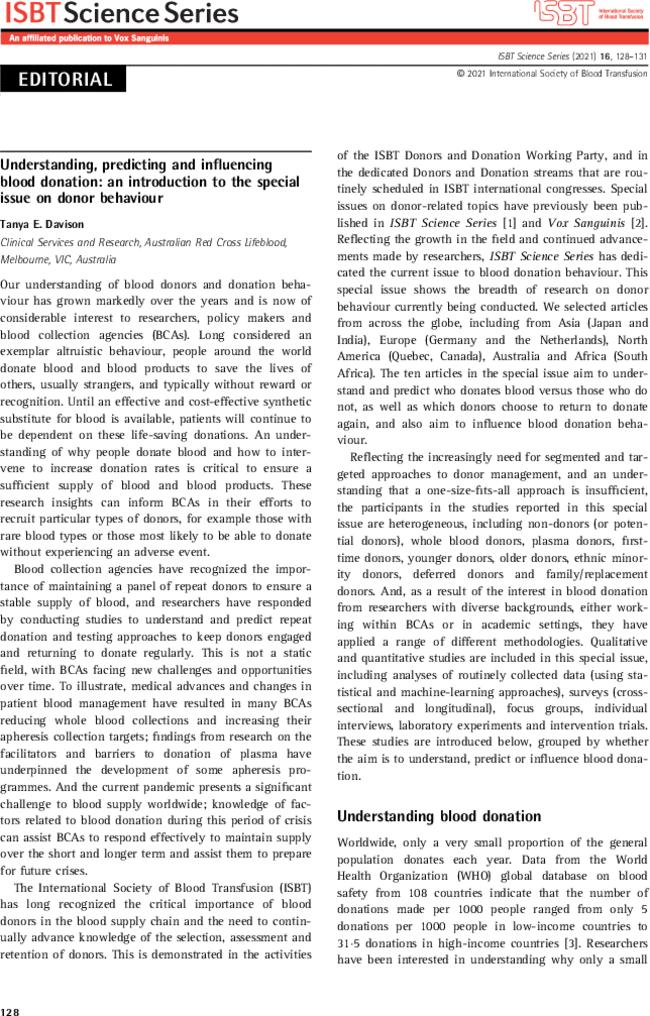Understanding, predicting and influencing blood donation: an introduction to the special issue on donor behaviour
引用次数: 0
Abstract
Our understanding of blood donors and donation behaviour has grown markedly over the years and is now of considerable interest to researchers, policy makers and blood collection agencies (BCAs). Long considered an exemplar altruistic behaviour, people around the world donate blood and blood products to save the lives of others, usually strangers, and typically without reward or recognition. Until an effective and cost-effective synthetic substitute for blood is available, patients will continue to be dependent on these life-saving donations. An understanding of why people donate blood and how to intervene to increase donation rates is critical to ensure a sufficient supply of blood and blood products. These research insights can inform BCAs in their efforts to recruit particular types of donors, for example those with rare blood types or those most likely to be able to donate without experiencing an adverse event. Blood collection agencies have recognized the importance of maintaining a panel of repeat donors to ensure a stable supply of blood, and researchers have responded by conducting studies to understand and predict repeat donation and testing approaches to keep donors engaged and returning to donate regularly. This is not a static field, with BCAs facing new challenges and opportunities over time. To illustrate, medical advances and changes in patient blood management have resulted in many BCAs reducing whole blood collections and increasing their apheresis collection targets; findings from research on the facilitators and barriers to donation of plasma have underpinned the development of some apheresis programmes. And the current pandemic presents a significant challenge to blood supply worldwide; knowledge of factors related to blood donation during this period of crisis can assist BCAs to respond effectively to maintain supply over the short and longer term and assist them to prepare for future crises. The International Society of Blood Transfusion (ISBT) has long recognized the critical importance of blood donors in the blood supply chain and the need to continually advance knowledge of the selection, assessment and retention of donors. This is demonstrated in the activities of the ISBT Donors and Donation Working Party, and in the dedicated Donors and Donation streams that are routinely scheduled in ISBT international congresses. Special issues on donor-related topics have previously been published in ISBT Science Series [1] and Vox Sanguinis [2]. Reflecting the growth in the field and continued advancements made by researchers, ISBT Science Series has dedicated the current issue to blood donation behaviour. This special issue shows the breadth of research on donor behaviour currently being conducted. We selected articles from across the globe, including from Asia (Japan and India), Europe (Germany and the Netherlands), North America (Quebec, Canada), Australia and Africa (South Africa). The ten articles in the special issue aim to understand and predict who donates blood versus those who do not, as well as which donors choose to return to donate again, and also aim to influence blood donation behaviour. Reflecting the increasingly need for segmented and targeted approaches to donor management, and an understanding that a one-size-fits-all approach is insufficient, the participants in the studies reported in this special issue are heterogeneous, including non-donors (or potential donors), whole blood donors, plasma donors, firsttime donors, younger donors, older donors, ethnic minority donors, deferred donors and family/replacement donors. And, as a result of the interest in blood donation from researchers with diverse backgrounds, either working within BCAs or in academic settings, they have applied a range of different methodologies. Qualitative and quantitative studies are included in this special issue, including analyses of routinely collected data (using statistical and machine-learning approaches), surveys (crosssectional and longitudinal), focus groups, individual interviews, laboratory experiments and intervention trials. These studies are introduced below, grouped by whether the aim is to understand, predict or influence blood donation.

了解、预测和影响献血:献血者行为特刊简介
多年来,我们对献血者和献血行为的了解显著增加,现在研究人员、政策制定者和血液采集机构(BCA)对此非常感兴趣。长期以来,世界各地的人们一直被认为是无私行为的典范,他们献血和血液制品是为了拯救他人的生命,通常是陌生人,通常没有报酬或认可。在获得有效且具有成本效益的合成血液替代品之前,患者将继续依赖这些拯救生命的捐赠。了解人们为什么献血以及如何进行干预以提高献血率,对于确保血液和血液制品的充足供应至关重要。这些研究见解可以为BCA招募特定类型的献血者提供信息,例如那些血型罕见的献血者或那些最有可能在没有发生不良事件的情况下献血的献血者。血液采集机构已经认识到维持一个重复献血者小组以确保血液稳定供应的重要性,研究人员通过进行研究来了解和预测重复献血,并通过测试方法来保持献血者的参与和定期返回献血。这不是一个静态的领域,随着时间的推移,BCA面临着新的挑战和机遇。举例来说,医学进步和患者血液管理的变化导致许多BCA减少了全血采集并增加了单采采集目标;对捐献血浆的促进者和障碍的研究结果为一些单采方案的发展奠定了基础。当前的疫情对全球血液供应提出了重大挑战;了解这一危机时期与献血相关的因素,可以帮助BCA有效应对,在短期和长期内保持供应,并帮助他们为未来的危机做好准备。国际输血学会(ISBT)长期以来一直认识到献血者在血液供应链中的关键重要性,以及不断提高献血者的选择、评估和保留知识的必要性。这体现在ISBT捐助者和捐赠工作组的活动中,以及ISBT国际大会定期安排的专门捐助者和捐赠流中。与捐助者有关的专题此前已发表在ISBT科学系列[1]和Vox Sanguinis[2]上。反映了该领域的发展和研究人员的持续进步,ISBT科学系列将当前的问题专门用于献血行为。这期特刊展示了目前对捐助者行为的广泛研究。我们选择了来自全球各地的文章,包括亚洲(日本和印度)、欧洲(德国和荷兰)、北美(魁北克、加拿大)、澳大利亚和非洲(南非)。特刊上的十篇文章旨在了解和预测谁献血,谁不献血,以及哪些献血者选择再次返回献血,还旨在影响献血行为。本期特刊报道的研究参与者多种多样,包括非捐献者(或潜在捐献者)、全血捐献者、血浆捐献者、首次捐献者、年轻捐献者、老年捐献者、,延期捐助者和家庭/替代捐助者。而且,由于具有不同背景的研究人员对献血感兴趣,无论是在BCA内部还是在学术环境中,他们都应用了一系列不同的方法。本特刊包括定性和定量研究,包括对常规收集的数据的分析(使用统计和机器学习方法)、调查(横断面和纵向)、焦点小组、个人访谈、实验室实验和干预试验。以下介绍这些研究,根据目的是了解、预测还是影响献血进行分组。
本文章由计算机程序翻译,如有差异,请以英文原文为准。
求助全文
约1分钟内获得全文
求助全文

 求助内容:
求助内容: 应助结果提醒方式:
应助结果提醒方式:


